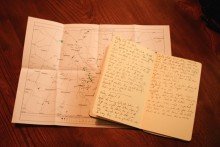Most astronomers record their observing sessions in some way (level of detail varies, and some even include sketches). They may post them on blogs or on astronomy forums, but as often as not it’s just to record what they’ve seen for their own information. I usually scribble down some notes at the time, and expand upon them later. I really enjoy looking over my observations at a later date, learning from them, and using them to plan future sessions. So, for those who have no experience of astronomy sessions, or who don’t know what you can expect to see, here’s an observing report I wrote up following a session on Friday, August 7.
I usually make a plan before I go observing. I write down a list of objects I’d like to see, their locations, sometimes print out a star chart (I use the excellent, and free, Cartes du Ciel skychart for this purpose) or just make some sketches. However, this time I hadn’t had time to prepare, apart from a 5-minute collimation check (optics alignment) earlier in the evening.
I began the evening at around 10PM. Sky still relatively bright, but with a couple of stars beginning to appear. As soon as I got the scope set up I noticed the International Space Station beginning its first transit of the evening. Amazingly, I was able to track it with my telescope (no easy feat with a dobsonian-mounted scope; the ISS moves pretty quickly!).
Without waiting for the scope to cool I popped in my 16mm Explore Scientific MaxVision (gives 75 times magnification in my scope) and aimed at Saturn. Although quite low in the sky at the moment, somewhat past its best, and with a fair amount of shimmering atmosphere to look through, I was surprised at how sharp the planet appeared. No Cassini division or detail on the surface, but, nevertheless, it was a very nice sight.
After half an hour or so the sky had darkened enough that I considered getting on with checking out the Bubble, Crescent and Iris nebulae, plus, perhaps, the Elephant’s trunk and Wizard nebulae. These objects have been on my list of things to look out for for some time now, and so, with no other plan in place for the evening, I thought I’d give them a go.
I fitted an OIII (nebula) filter in my 24mm eyepiece (gives 50 times magnification in my scope) and I was off. First up was the Bubble nebula. I found M52 in Cassiopeia easily enough, but try as I might I couldn’t find the Bubble. Even later when the sky was properly dark, there was just no sign of it. Anyway, to cut a long story short, I had no luck with the others either. So, now with no plan left to speak of, I settled in to an evening of just scanning through the Milky Way, checking out some old favourites, and switching between the scope and my 20×80 binoculars.
Over the course of the evening I managed a look at the following: Kemble’s Cascade, the Perseus double, Owl, and Wild Duck (M11) clusters (all incredibly sparkly and clear), the Andromeda, Cigar, Bodes, Whirlpool, Triangulum, and Pinwheel galaxies (not as clear and as detailed as I’d expected but still pretty good), the Veil nebula in Cygnus (when viewed with the scope this was less good than on previous nights, but, surprisingly, quite clear in the binoculars!). I also checked out a number of globular clusters, including the wonderful M13, plus M92, M2 and M22, all lovely and sparkly (the latter very large and incredibly detailed, despite it’s low altitude), and the Eagle, Omega, Lagoon and Trifid nebulae (a little disappointing to be honest; not as clear as on previous nights).
A pattern was starting to emerge. Stellar, sparkly objects looked great, but fainter, more nebulous objects weren’t so good. Although the sky was dark enough, and the Milky Way fairly clear overhead, there must have been some humidity or thin cloud in the atmosphere negatively affecting all but the brightest and clearest objects. Still, I was having fun, and I even got to tick off another Messier object from my list (M73, a small and rather uninspiring asterism in Aquarius).
With the time now around 12.30, and the moon due up any minute, I quickly scanned around with Google Sky Map on my phone and discovered that Neptune was fairly high, and in a relatively dark part of the sky. ‘Worth a shot’, I thought. A couple of minutes later there it was: a small, pale, bluish orb. Incredible! The outermost planet in the solar system (no offence Pluto-philes). There was also a tiny speck below it, which Stellarium later confirmed was the planet’s largest moon, Triton! Absolutely thrilling! I spent about 15 minutes on it, trying different eyepieces to get the best view (16mm MaxVision yet again!)
It is, of course, Perseid season, with the peak time for viewing them around the middle of August. Several appeared in the course of the session, some leaving long streaks across the sky.
All in all, the two and a half hours I spent out observing flew by, and even after spending a little while writing up my notes I was still buzzing by the time I got home. I mean, seeing Neptune, with your own eyes … how cool is that!
Clear skies!
Kevin Quinn is an amateur astronomer based in Cerne Abbas, he is the proud owner of a ten-inch reflector and a hefty pair of binoculars. He tweets via @CerneAstro, blogs via theastroguy.wordpress.com, and his book ‘Demystifying Astronomy – A beginner’s guide to telescopes, eyepieces and accessories for visual astronomy’ is widely available.
©Kevin Quinn












